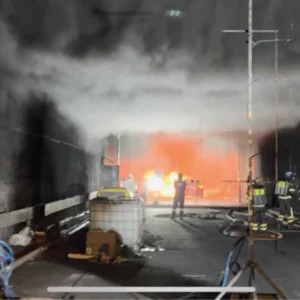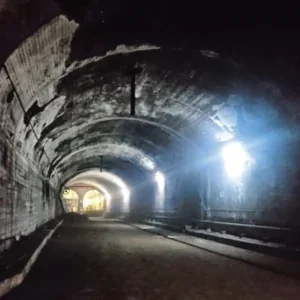Few of the many drivers heading north on London’s M25 ring motorway will notice anything unusual when they pass through the twin tunnels under the Thames estuary at Dartford. Somewhere in the 1.44km length of the western bore they might feel a slight bump as they pass over a steel link plate.
The very observant might also notice that the road surface looks different. But they would be hard pressed to spot that a large chunk of the tunnel had been ripped out and replaced just hours before the morning rush hour got under way.
Yet, for months now, just such an operation has been carried out, with almost military precision, each and every night, with an extended possession at weekends when two sections are tackled. Slowly but surely, the road deck is being replaced.
The operation is needed because of the ravages of time and, as importantly, road salt and moisture. "The top of the old deck is delaminating because of chloride attack," explains Peter Barringer the rebuild’s project manager for contractor Skanska Construction, until recently Kværner Construction.
Various insitu repairs had been made to the deck and, in the last decade, a cathodic protection system has been employed. "But three years ago the client decided to replace it," says Barringer. Client is the Dartford River Crossing company.
The 8.7m id circular cross-section tunnel was built in an extended and often fraught compressed air drive with shields in the late 1950s. Ground proved troublesome, with silty clays and peats, areas of broken chalk and wet gravels. Two short portal area sections were done by cut and cover.
Once completed in 1959, the cast-iron segment lined bore was fitted with a suspended acoustic ceiling and a concrete road deck, the latter comprising a 225mm thick reinforced concrete slab supported on a central longitudinal wall 175mm thick.
This T unit was freely supported on the benching and side walls. "But it thickens here and appears to have been cast into the pan of the cast iron segments to form the walkway on top," says Barringer.
Just how to get this deck demolished and replaced during a series of night-time possessions was the challenge facing the contractors bidding for the job in July last year. "We are allowed a nine and a half hour period each night with a 14 hour period on Saturday night," says Barringer. It goes without saying that the two lane tunnel, carrying northbound rush hour traffic on the M25, must unfailingly be open in the morning.
Just to make things awkward, neither was the work to affect four extremely large oilbath power cables which run beneath the road deck in the tunnel invert. Each carries 275kW and together they supply around half of the electricity used in north London.
"We devised a steel cage box, each sitting over two cables," explains Barringer. "We showed the National Grid a video of a heavy steel object being dropped on it, edge on, and they were satisfied." These boxes are installed 30m ahead of the run of work and are a limiting factor on the length worked at one time.
The deck replacement itself is done in just under 7m sections, cutting out the old deck, lifting it away and then bringing in new precast segments. These span the full tunnel width to create the 6.46m wide road deck, and have no centre support.
"We choose the replacement length mainly because of the way the tunnel was built," explains Barringer. The original deck installation used precast T sections 19 ft 6 in (6m) long, with the bottom of the T grouted into a channel along the invert. Sections were stitched together 3ft (0.92m) apart with insitu concrete. They were also concreted on to the side wall. This forms a thickened "haunch" on either side.
Importantly these haunches also contain vent ducts at 450mm centres made with asbestos cement. By cutting only at the original stitches, these sections can be taken out without unduly disturbing this potentially dangerous material which is broken up off site under controlled conditions.
The work sequence involves preparing the tunnel ahead of the main nightly operation. Cable protectors are laid and new concrete plinths poured in the space underneath the road deck, using the ventilator ducts for pump access. The 1m high plinths serve as temporary supports during demolition as well as permanent support for the new deck’s bearings.
"Next, we cut the vertical wall using a concrete diamond corer to make a 200mm core down through it." Core drills also cut through the haunches, with an angled pattern. "We use four drills linked up and controlled remotely by one guy." Cores are also made through the deck as lifting points for later removal.
This process is ongoing up to 3m ahead of the main operation where a deck section is lifted out. For this, subcontractor Robocore makes longitudinal and lateral diamond saw cuts through the deck to leave a 4.85m wide by 6.8m section supported with temporary steelwork on the plinths below.
Purpose built units, made by Kværner Construction sister company Cementation are drawn up for the tightly choreographed removal operation.
First in is a trailer carrying a portal lifting gantry. This has steel legs 5m apart and two travelling hoist winches, each of 25t capacity. Two legs are positioned on the existing road deck beyond the cut point and two on new section replaced the night before.
Steel lifting beams are bolted through core holes in each end of the 30t central cut-out section, and it is lifted vertically. "It usually comes free, though sometimes we need a burster to loosen the grout around the T wall base," says Barringer.
Meanwhile, a trailer with a slot along the centre has backed into the tunnel and the unit is gently trolleyed backwards onto it. Limited headroom is a problem. "The tunnel is 5m high and the gantry lifting frame here takes 3m, sitting on the 2m of the T-section deck. We can just get the section onto the truck," explains Mike Bradley the works manager on the night shift. Special jacks later lift the unit to give road clearance.
The attention of the eight-strong team then turns to the haunches, now supported by a longitudinal beam; these are removed leaving just a stub at each end. Slides, made up of two fabricated beams are positioned at each end, with a hydraulic Tirfor between them, supported on the new plinths and a steel beam across the tunnel invert. A small sledge with pulleys sits on the slide and is bolted through the deck.
"When ready, a 50t jack at each corner tilts the haunch and breaks the bond where it is concreted against the tunnel wall," says Barringer. One haunch is strutted against the centre stop of the temporary work beam as an anchor to pull the other in. The total 22t is lifted by a lift beam and chain slings, and trolleyed on winches to a standard truck. Behind them the team gets busy cleaning the plinths and tunnel floor ready for new sections.
These arrive in two parts, for manoeuvrability. The 6m wide units would be too big for the lifting frame which straddles only 5m, explains Barringer. But trucking in half-length replacement sections of 3.5m long, turned 90° to its final position, they also fit through the gantry space. Once gingerly moved through the legs of the gantry, the sections are turned using a purpose built turntable on the back of the delivery truck. Consultant Tony Gee and Partner helped design the temporary works.
"We have to get that position right because the units are match cast, much like a segmental bridge," says Barringer. Units are made in two precast lines in nearby yard.
A special lifting frame is pre-fitted to the unit which can be attached to the gantry’s lift beam without wasting time with bolts through the deck. The unit is lowered into position, with final adjustments by flat jacks. The second unit simply slots in.
An epoxy glue is applied just-in-time for shear and waterproofing and each unit is then stressed against the previous one with four bars through ducts.
Once positioned and levelled on jacks, temporary steel bearings are installed to accept the next day’s traffic. Permanent bearings go in over the next two or three shifts, grouted in with rapid strength gain epoxy, freeing the temporary bearings to be moved forwards for new sections.
The new deck is slightly lower than the old one increasing tunnel headroom, and is also flatter, removing up to 80mm or so of switchback undulation. "We also remove some irregular camber," says Barringer.
It only remains to fix wooden wedges alongside the new section and a steel connection ramp to the remaining old deck. Until final surfacing, traffic will run on stone mastic asphalt built up over waterproofing and base course layers as part of the precast.
When T&TI visited the site, the nighly operation went like clockwork and Barringer says that section replacement is down to three and half hours.
But it did not start so well. Even after six months of planning, the first night possession in May needed 14 hours and the second nearly 10. But so far, Barringer says, there has been no call on the emergency section of decking kept by just in case.
Altogether there are 207 sections of the old deck to come out and 415 new units to go in – one section needs three units to replace it. Completion is due at the end of January, followed by a six week period for final finishes and surfacing work.
Related Files
Figure 2
Figure 1






